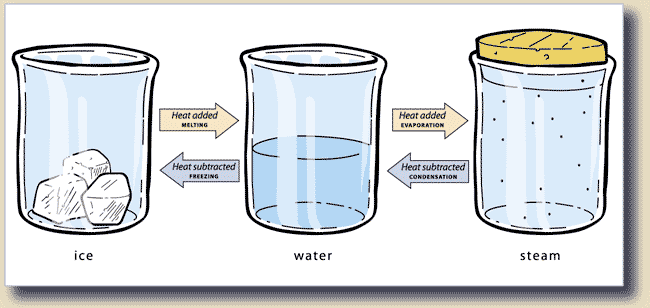| Approach: One
to one |
Level:
Year 4
and year 8 |
|
| Focus:
Evaporation
and condensation
|
| Resources:
Video recording
on laptop computer, picture |
 |
468KB |
|
|
| Questions/instructions:
This
activity uses the computer.
Place the picture of the water cycle in front of the student. |
 |
|
| |
%
responses |
y4 |
y8 |
1.
Here is a picture showing the three forms of water. Use the picture to
tell me how water changes.
|
ice
becomes water when it is heated and/or melts |
70 |
84 |
water
becomes ice when it is cooled and/or freezes |
25 |
51 |
water
becomes steam when it is heated and/or evaporates |
39 |
74 |
steam
becomes water when it is cooled and/or condenses |
9 |
33 |
Point
to the appropriate arrows as you give the following explanation.
So if you heat ice, it will become water. If you cool down or freeze water
it will become ice. If you heat water, it will become steam. If you cool
steam, it will become water. |
|
|
Now
I’ll show you a video which shows dirty water being turned into
clean water. Then I’ll ask you to tell me how the dirty water
was turned into clean water.
Click the Dirty Water button. The video will start.

[No sound. Video demonstrates placing
empty glass in hot dirty water; covering bowl with gladwrap; placing
weight in centre of covering above empty glass; closeup of droplets
running down toward weight and dripping into the glass; removing weight
and covering; showing glass now with clean water.]
|
|
|
2.
Tell me how some of the dirty water was turned into clean water.
|
water
in bowl evaporates/turns to steam |
35 |
72 |
dirt
stays in rest of water |
5 |
25 |
steam
condenses on plastic wrap/becomes water droplets on plastic wrap |
20 |
60 |
water
droplets slide down plastic wrap to low point (centre)
|
24 |
63 |
(clean)
water droplets fall into glass |
48 |
88 |
| |
|
|
Total
score:
|
8–9 |
1 |
20 |
6–7
|
9 |
34 |
4–5
|
23 |
29 |
2–3
|
36 |
13 |
0–1
|
31
|
4 |
Commentary:
Year 8 students
performed much better than year 4 students on this task.
|